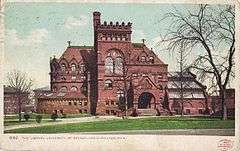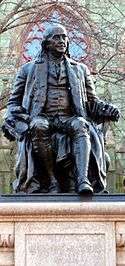Furness Library
|
Fine Arts Library (Furness Library), University of Pennsylvania | |
|
University of Pennsylvania Library in 1904. | |
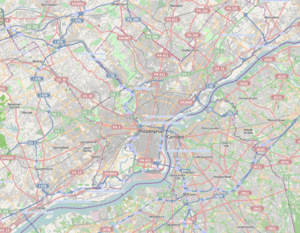   | |
| Location | Philadelphia, Pennsylvania |
|---|---|
| Coordinates | 39°57′05″N 75°11′33″W / 39.95139°N 75.19250°WCoordinates: 39°57′05″N 75°11′33″W / 39.95139°N 75.19250°W |
| Area | 116,000 sq ft[1] |
| Built | 1888-91 |
| Architect |
Frank Furness; Furness, Evans, & Co. |
| Architectural style | Venetian Gothic, Victorian |
| NRHP Reference # | 72001154 |
| Significant dates | |
| Added to NRHP | May 19, 1972[2] |
| Designated NHL | February 4, 1985[3] |
The Furness Library, officially known as the Fisher Fine Arts Library, is located on the campus of the University of Pennsylvania, on the east side of College Green. Designed by the acclaimed Philadelphia architect Frank Furness (1839–1912), the red sandstone, brick-and-terra-cotta Venetian Gothic giant—part fortress and part cathedral—was built to be the primary library of the University, and to house its archeological collection. The cornerstone was laid in October 1888, construction was completed in late 1890, and the building was dedicated in February 1891.[4] Renamed the Furness Building after its architect, the building was listed in the National Register of Historic Places in 1985.[5]
| “ | "It is the work of an artist." — Frank Lloyd Wright. | ” |
Design
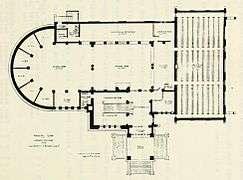
The library's plan is exceptionally innovative: circulation to the building's five stories is through the tower's staircase, separated from the reading rooms and stacks.
The Main Reading Room is a soaring four-story brick-and-terra-cotta-enclosed space, divided by an arcade from the two-story Rotunda Reading Room. The latter has a basilica plan – with seminar rooms grouped around an apse (like side-chapels) – the entire space lighted by clerestory windows. Above the Rotunda Reading Room is a two-story lecture hall, now an architecture studio. The Main Reading Room, with its enormous skylight and wall of south-facing windows, acts as a lightwell, illuminating the surrounding inner rooms through leaded glass windows.
The three-story fireproof stacks are housed in a modular iron wing, with a glass roof and glass-block floors to help light the lower levels. It was designed to initially hold 100,000 books – but also to be continuously expandable, one bay at a time, with a movable south wall. Furness's perspective drawing highlighted this growth potential by showing a nine-bay stacks,[6] although the initial three-bay stacks were never expanded.
Throughout the building are windows inscribed with quotations from Shakespeare, chosen by Horace Howard Furness (Frank's older brother), a University lecturer and a preeminent American Shakespearean scholar of the 19th century. The architect collaborated with Melvil Dewey, creator of the Dewey Decimal System, and others to make this the most modern American library building of its time.[7]
| “ | "The plans I sketched with Mr. Furness late that evening, seem to me better than any college library has yet adopted." — Melvil Dewey.[8] | ” |
Rejection
Within a generation, Frank Furness's exuberant masterwork was considered an embarrassment. The University Museum moved to its own building in 1899. In 1915, the Duhring Wing was built at the south end of the stacks, making their designed expansion impossible.[9] Architect Robert Rodes McGoodwin drew up plans to cloak the entire building in sedate Collegiate Gothic brick and stone.[10] The first step toward this was the 1931 addition of a reading room facing College Green (now the Arthur Ross Gallery) that masked the iron-and-glass stacks.[11] Almost perversely, McGoodwin's incongruous Collegiate Gothic addition was dedicated as a memorial to Horace Howard Furness.[12]
The building served as the main library of the University of Pennsylvania until the construction of Van Pelt Library in 1962. Today it houses collections related to architecture, landscape architecture, city and regional planning, historic preservation, history of art, and studio arts.
Belated appreciation
In 1957, the Philadelphia Evening Bulletin columnist and cartoonist Alfred Bendiner invited Frank Lloyd Wright to tour the Victorian behemoth, then threatened with demolition. The architect proclaimed: "It is the work of an artist."[13]
The Furness Library was listed on the National Register of Historic Places in 1972;[2] was additionally listed as a contributing property in the University of Pennsylvania Campus Historic District in 1978; and was declared a National Historic Landmark in 1985.[1][3]
Between 1986 and 1991, the building was restored by a team that included Venturi, Scott Brown & Associates, Inc., CLIO Group, Inc., and Marianna Thomas Architects.[14][15] On the occasion of its centennial in February 1991, it was rededicated as the "Anne & Jerome Fisher Fine Arts Library" (named for the restoration's primary benefactors). The $16.5-million restoration garnered rave reviews from New York Times architectural critic Paul Goldberger,[16] and received national awards from the Victorian Society in America (1991), the Advisory Council on Historic Preservation (1992), and the American Institute of Architects (1993).[12]
The restored building was featured prominently in the 1993 film Philadelphia.
In a 2009 appreciation in The Wall Street Journal, architectural historian Michael J. Lewis called it "a cheeky act of architectural impertinence" and "the last of its kind": "Today, the University of Pennsylvania building, now known as the Fisher Fine Arts Library, is widely acknowledged as one of the great creations of 19th-century American culture, and the principal work of its architect, Frank Furness (1839-1912)."[17]
Arthur Ross Gallery
Horace Howard Furness's collection of Shakespeareana was moved to Van Pelt Library in the 1960s. The former Furness Reading Room was converted into the Arthur Ross Gallery, which houses the University's art collection. Opened in 1983,[18] the gallery is named for its benefactor, noted philanthropist Arthur Ross, who started his college studies at the University of Pennsylvania, but later transferred to Columbia University.[19] Admission to the public is free.
Exterior
.jpg) University of Pennsylvania Library in 1900. The glass-roofed book stacks (right) were designed with a movable end wall, so they could be continuously expanded.
University of Pennsylvania Library in 1900. The glass-roofed book stacks (right) were designed with a movable end wall, so they could be continuously expanded.- The auditorium (now an architecture studio) occupies the apse's 3rd and 4th stories.
- The apse, 2013. Skylights light the windowless 1st-story seminar rooms.
- Gargoyles.
- A gable on the east façade denotes the 3rd-story auditorium.
- Detail of the porch.
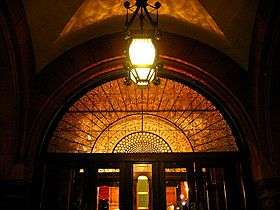 Lantern of the porch and the leaded glass fanlight.
Lantern of the porch and the leaded glass fanlight.
Interior
- Interior view of the leaded glass fanlight (with a Shakespearean quote).
- The tower's staircase. The newel post lamps are re-creations from the 1991 restoration.
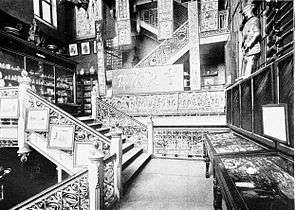 The upper levels of the tower's staircase were used to display anthropological artifacts in 1896.
The upper levels of the tower's staircase were used to display anthropological artifacts in 1896.- Newel post knob.
- The tower's great window, looking west.
- The Main Reading Room's locomotive-inspired fireplace.
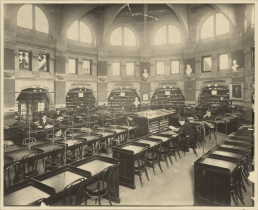 The Rotunda Reading Room, circa 1900.
The Rotunda Reading Room, circa 1900.- The Rotunda Reading Room in 2013. Massive iron beams support the auditorium above it.
References
- 1 2 Carolyn Pitts (1984-08-10). "National Register of Historic Places Inventory-Nomination: Furness Library, School of the Fine Arts, University of Pennsylvania" (pdf). National Park Service. and Accompanying four photos from 1964 (32 KB)
- 1 2 National Park Service (2007-01-23). "National Register Information System". National Register of Historic Places. National Park Service.
- 1 2 "Furness Library, School of Fine Arts, University of Pennsylvania". National Historic Landmark summary listing. National Park Service. Retrieved 2008-07-03.
- ↑ Applications for Historical Landmark Status Accessed July 20, 2007
- ↑ http://focus.nps.gov/nrhp/AssetDetail?assetID=8ca1cbaa-5ab9-4094-97e2-fce8f6ccedeb
- ↑ Elevation and perspective drawing from Architectural Archives, University of Pennsylvania
- ↑ Edward R. Bosley, University of Pennsylvania Library (London: Phaidon Press, 1996), pp. 17-22.
- ↑ Melvil Dewey to Provost William Pepper, 20 April 1887, University of Pennsylvania Archives.
- ↑ Duhring Wing, from University of Pennsylvania.
- ↑ Proposed alterations to University of Pennsylvania Library (1931) from University of Pennsylvania Architectural Archives.
- ↑ Arthur Ross Gallery from University of Pennsylvania.
- 1 2 Bosley, p. 60.
- ↑ Alfred Bendiner, Bendiner's Philadelphia (New York: A.S. Barnes & Company, 1964), pp. 40-41. Bendiner cartoon from Architectural Archives, University of Pennsylvania
- ↑ Restoration drawings from Architectural Archives, University of Pennsylvania
- ↑ "Restoration of the Furness Building/Fisher Fine Arts Library, University of Pennsylvania" (PDF). Venturi, Scott Brown and Associates. Retrieved December 12, 2013.
- ↑ Paul Goldberger, "In Philadelphia, a Victorian Extravaganza Lives," The New York Times, June 2, 1991.
- ↑ Michael J. Lewis, "This Library Speaks Volumes," The Wall Street Journal, November 14, 2009.
- ↑ "History". Arthur Ross Gallery. Retrieved 21 December 2014.
- ↑ Martin, Douglas (2007-09-11). "Arthur Ross, Investor and Philanthropist Who Left Mark on the Park, Dies at 96". New York Times. Retrieved 2014-12-21.
External links
| Wikimedia Commons has media related to Fisher Fine Arts Library. |
- Official Site
- Arthur Ross Gallery
- Historic American Buildings Survey: 10 photos
- Furness Fine Arts Building in Winter
